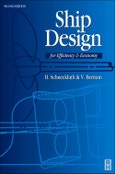The previous edition of Ship Design for Efficiency and Economy was published as a Butterworth's marine engineering title. It has now been completely revised and updated by Schneekluth and Bertram.This book gives advice to students and naval architects on how to design ships - in particular with regard to hull design. The previous edition of this book was published in 1987. Since then, there have been numerous important developments in this area and the new additions to this book reflect these changes. Chapter 3 has been completely rewritten with added information on methodology of optimization, optimization shells and concept exploration methods. There is also a new sub-chapter on Computational Fluid Dynamics (CFD) for ship-hull design. Plus, a new method to predict ship resistance based on the evaluation of modern ship hull design will be detailed.
The emphasis of the this book is on design for operational economy. The material is directly usable not only in practice, in the design office and by shipowners, but also by students at both undergraduate and postgraduate levels.
Please Note: This is an On Demand product, delivery may take up to 11 working days after payment has been received.








